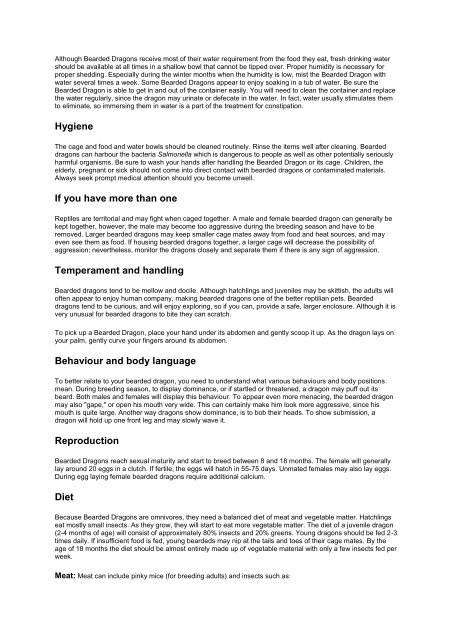Bearded Dragon Care Sheet - Shires Veterinary Practice
Bearded Dragon Care Sheet - Shires Veterinary Practice
Bearded Dragon Care Sheet - Shires Veterinary Practice
You also want an ePaper? Increase the reach of your titles
YUMPU automatically turns print PDFs into web optimized ePapers that Google loves.
Although <strong>Bearded</strong> <strong>Dragon</strong>s receive most of their water requirement from the food they eat, fresh drinking water<br />
should be available at all times in a shallow bowl that cannot be tipped over. Proper humidity is necessary for<br />
proper shedding. Especially during the winter months when the humidity is low, mist the <strong>Bearded</strong> <strong>Dragon</strong> with<br />
water several times a week. Some <strong>Bearded</strong> <strong>Dragon</strong>s appear to enjoy soaking in a tub of water. Be sure the<br />
<strong>Bearded</strong> <strong>Dragon</strong> is able to get in and out of the container easily. You will need to clean the container and replace<br />
the water regularly, since the dragon may urinate or defecate in the water. In fact, water usually stimulates them<br />
to eliminate, so immersing them in water is a part of the treatment for constipation.<br />
Hygiene<br />
The cage and food and water bowls should be cleaned routinely. Rinse the items well after cleaning. <strong>Bearded</strong><br />
dragons can harbour the bacteria Salmonella which is dangerous to people as well as other potentially seriously<br />
harmful organisms. Be sure to wash your hands after handling the <strong>Bearded</strong> <strong>Dragon</strong> or its cage. Children, the<br />
elderly, pregnant or sick should not come into direct contact with bearded dragons or contaminated materials.<br />
Always seek prompt medical attention should you become unwell.<br />
If you have more than one<br />
Reptiles are territorial and may fight when caged together. A male and female bearded dragon can generally be<br />
kept together, however, the male may become too aggressive during the breeding season and have to be<br />
removed. Larger bearded dragons may keep smaller cage mates away from food and heat sources, and may<br />
even see them as food. If housing bearded dragons together, a larger cage will decrease the possibility of<br />
aggression; nevertheless, monitor the dragons closely and separate them if there is any sign of aggression.<br />
Temperament and handling<br />
<strong>Bearded</strong> dragons tend to be mellow and docile. Although hatchlings and juveniles may be skittish, the adults will<br />
often appear to enjoy human company, making bearded dragons one of the better reptilian pets. <strong>Bearded</strong><br />
dragons tend to be curious, and will enjoy exploring, so if you can, provide a safe, larger enclosure. Although it is<br />
very unusual for bearded dragons to bite they can scratch.<br />
To pick up a <strong>Bearded</strong> <strong>Dragon</strong>, place your hand under its abdomen and gently scoop it up. As the dragon lays on<br />
your palm, gently curve your fingers around its abdomen.<br />
Behaviour and body language<br />
To better relate to your bearded dragon, you need to understand what various behaviours and body positions<br />
mean. During breeding season, to display dominance, or if startled or threatened, a dragon may puff out its<br />
beard. Both males and females will display this behaviour. To appear even more menacing, the bearded dragon<br />
may also "gape," or open his mouth very wide. This can certainly make him look more aggressive, since his<br />
mouth is quite large. Another way dragons show dominance, is to bob their heads. To show submission, a<br />
dragon will hold up one front leg and may slowly wave it.<br />
Reproduction<br />
<strong>Bearded</strong> <strong>Dragon</strong>s reach sexual maturity and start to breed between 8 and 18 months. The female will generally<br />
lay around 20 eggs in a clutch. If fertile, the eggs will hatch in 55-75 days. Unmated females may also lay eggs.<br />
During egg laying female bearded dragons require additional calcium.<br />
Diet<br />
Because <strong>Bearded</strong> <strong>Dragon</strong>s are omnivores, they need a balanced diet of meat and vegetable matter. Hatchlings<br />
eat mostly small insects. As they grow, they will start to eat more vegetable matter. The diet of a juvenile dragon<br />
(2-4 months of age) will consist of approximately 80% insects and 20% greens. Young dragons should be fed 2-3<br />
times daily. If insufficient food is fed, young beardeds may nip at the tails and toes of their cage mates. By the<br />
age of 18 months the diet should be almost entirely made up of vegetable material with only a few insects fed per<br />
week.<br />
Meat: Meat can include pinky mice (for breeding adults) and insects such as:


